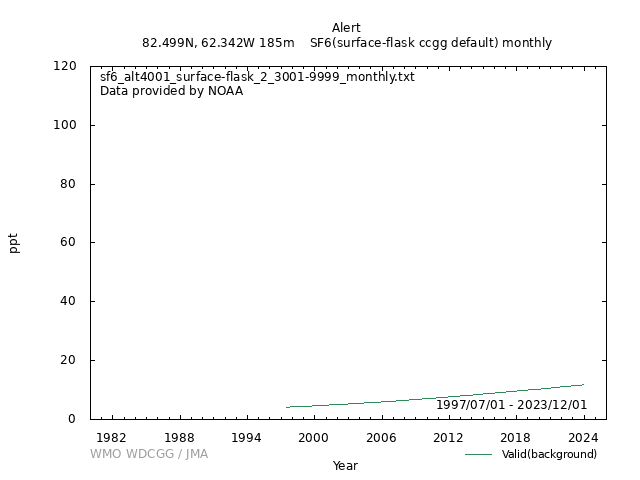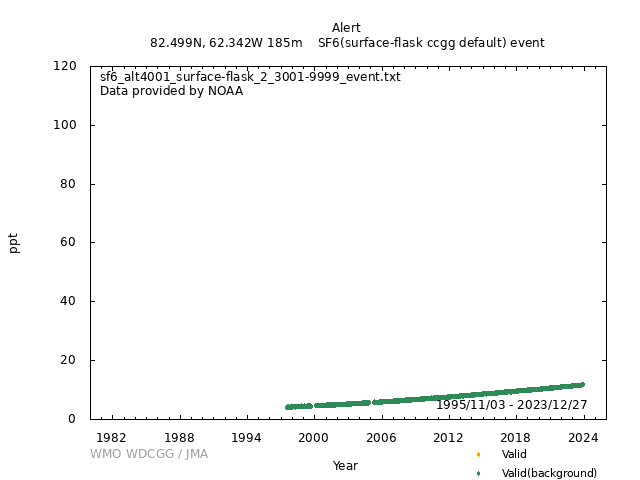Data Policy
GAW Data Policy
"For Scientific purposes, access to these data is unlimited and provided without charge.
By their use you accept that an offer of co-authorship will be made through personal contact with the data providers
or owners whenever substantial use is made of their data.
In all cases, an acknowledgement must be made to the data providers or owners and to the data centre when these data are used within a publication."
Version
2025-08-18-1048 (Last updated: 2025-08-21)File
This data set is submitted by NOAA.
In line with the GAW Data Policy, users should contact the contributors of all data of interest and propose co-authorship or acknowledgement.
Organization
| NO | 2 |
|---|---|
| Acronym | NOAA |
| Name | Global Monitoring Laboratory, NOAA |
| Address 1 | NOAA/ESRL |
| Address 2 | R/GML1 |
| Address 3 | 325 Broadway Boulder, CO 80305-3328 |
| Country/Territory | United States of America |
| Website | https://gml.noaa.gov/ |
Contact(s)
| Name | Xin Lan |
|---|---|
| Prefix | |
| xin.lan@noaa.gov | |
| Organization No | 2 |
| Organization acronym | NOAA |
| Organization name | Global Monitoring Laboratory, NOAA |
| Organization country/territory | United States of America |
| Address 1 | NOAA GML |
| Address 2 | 325 Broadway R/GML-1 |
| Address 3 | Boulder, CO 80305-3328 |
| Country/territory | United States of America |
| Tel | |
| Fax | |
| Last updated date | 2025-08-18 |
|
|||||||||||||||||||||||||||
| Background observation | |||||||||||||||||||||||||||
| UTC | |||||||||||||||||||||||||||
| ppt | |||||||||||||||||||||||||||
|
9999-12-31 00:00:00 - 9999-12-31 23:59:59: WMO SF6 X2014 |
|||||||||||||||||||||||||||
|
9999-12-31 00:00:00 - 9999-12-31 23:59:59: Unknown(Gas chromatography (ECD)) |
|||||||||||||||||||||||||||
| weekly | |||||||||||||||||||||||||||
|
UNCERTAINTIES Random Error We report SF6 measurement uncertainties that are based on our ability to propagate the WMO XSF6 scale to working standards, the repeatability of the analyzers used for sample measurement, and the long-term reproducibility of analyzer responses. The average repeatability of the analytical system is approximately 0.04 ppt. Reproducibility for our measurements (1 sigma) is approximately 0.01 ppt, based on repeated analysis of air from a high-pressure cylinder, or the long-term variability in the differences between measurements of test flasks on the sample analysis system and separate measurements on the calibration system of the test gas used to fill the test flasks. Scale-propagation uncertainty is estimated to be 0.01 ppt, based on the reproducibility determined for scale propagation in our calibration laboratory. These three components of uncertainty are added in quadrature to calculate the measurement uncertainty. Correction of Systematic Errors No bias correction of systematic errors are applied to SF6 data. |
|||||||||||||||||||||||||||
|
[Hourly] [Daily] [Monthly] Monthly means are produced for each site by first averaging all retained measurement results in the event file with a unique sample date and time. Values are then extracted at weekly intervals from a smooth curve (Thoning et al., 1989) fitted to the averaged data and these weekly values are averaged for each month to give the monthly means recorded in the files. Flagged data are excluded from the curve fitting process. Some sites are excluded from the monthly mean directory because sparse data or a short record does not allow a reasonable curve fit. Also, if there are 3 or more consecutive months without data, monthly means are not calculated for these months. |
|||||||||||||||||||||||||||
| This is the NOAA 3-character quality control flag. Column 1 is the REJECTION flag. An alphanumeric other than a period (.) in the FIRST column indicates a sample with obvious problems during collection or analysis. This measurement should not be interpreted. Column 2 is the SELECTION flag. An alphanumeric other than a period (.) in the SECOND column indicates a sample that is likely valid but does not meet selection criteria determined by the goals of a particular investigation. For example, it might not have been obtained during 'background' conditions. Column 3 is the INFORMATION flag. An alphanumeric other than a period (.) in the THIRD column provides additional information about the collection or analysis of the sample. A P in the 3rd column of the QC flag indicates the measurement result is preliminary and has not yet been carefully examined by the PI. The P flag is removed once the quality of the measurement has been determined. | |||||||||||||||||||||||||||
|
Valid (background): ... Valid (background): ..? Valid: .?? Invalid: ??? |
|||||||||||||||||||||||||||
| Operational/Reporting | |||||||||||||||||||||||||||
|
Atmospheric SF6 Dry Air Mole Fractions from the NOAA GML Global Greenhouse Gas Reference Network, Carbon Cycle Cooperative Global Air Sampling Network: 1997 - Present These data are provided by NOAA. Principal investigators include Xin Lan (NOAA). Key partners include Doug Worthy (ECCC). Please cite the product's citation when using data from this dataset : Lan, X., G. Petron, K. Baugh, A.M. Crotwell, M.J. Crotwell, S. DeVogel, M. Madronich, J. Mauss, T. Mefford, E. Moglia, S. Morris, J.W. Mund, A. Searle, K.W. Thoning, S. Wolter and J. Miller (2025), Atmospheric Sulfur Hexafluoride Dry Air Mole Fractions from the NOAA GML Global Greenhouse Gas Reference Network, Carbon Cycle Cooperative Global Air Sampling Network: 1997 - Present, Version: 2025-08-15, https://doi.org/10.15138/p646-pa37 |
|||||||||||||||||||||||||||
|
Wind direction: Wind speed: Relative humidity: Precipitation amount: Air pressure: Air temperature: Dew point temperature: Sea water temperature: Sea surface water temperature: Sea water salinity: Sea surface water salinity: |
|||||||||||||||||||||||||||
|
Meteorological data may remain as first provided, even when greenhouse gas data are updated. |
DOI Metadata
| DOI |
|
||||||||
|---|---|---|---|---|---|---|---|---|---|
| For more information, please refer: doi.org/10.15138/p646-pa37 | |||||||||
Related information
GAW Data Policy
"For Scientific purposes, access to these data is unlimited and provided without charge.
By their use you accept that an offer of co-authorship will be made through personal contact with the data providers
or owners whenever substantial use is made of their data.
In all cases, an acknowledgement must be made to the data providers or owners and to the data centre when these data are used within a publication."
Citation format
This format is an example of the WDCGG standard citation.
Please follow the citation format which the data providers or owners indicate.
Please follow the citation format which the data providers or owners indicate.
Xin Lan (NOAA),
Atmospheric SF6
at Alert by Global Monitoring Laboratory, NOAA,
dataset published as SF6_ALT4001_surface-flask_NOAA_ccgg at WDCGG,
ver. 2025-08-18-1048 (Reference date*: YYYY/MM/DD)
* As the reference date, please indicate the date you downloaded the files.
* As the reference date, please indicate the date you downloaded the files.
Reference(s)
| 1 | Lan, X., G. Petron, K. Baugh, A.M. Crotwell, M.J. Crotwell, S. DeVogel, M. Madronich, J. Mauss, T. Mefford, E. Moglia, S. Morris, J.W. Mund, A. Searle, K.W. Thoning, S. Wolter and J. Miller (2025), Atmospheric Sulfur Hexafluoride Dry Air Mole Fractions from the NOAA GML Global Greenhouse Gas Reference Network, Carbon Cycle Cooperative Global Air Sampling Network: 1997 - Present, Version: 2025-08-15, https://doi.org/10.15138/p646-pa37 |
|---|





